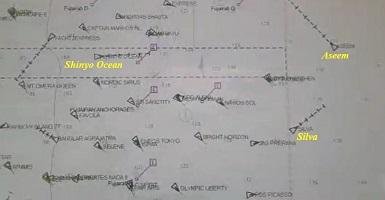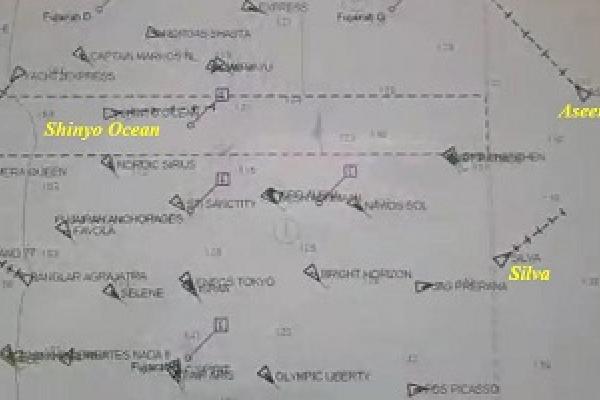
Steamship Mutual
Published: July 06, 2020

Source – MSIU, Transport Malta
(Page 11 of the published report)
Previously there have been a number of articles and reports written on the dangers associated with the use of VHF for the purposes of collision avoidance, with frequent reports of collisions between ships resulting from the delay in taking appropriate collision avoidance measures, the ship’s officers being pre-occupied communicating over the VHF.
A further investigation report has recently been published by the Marine Safety Investigation Unit (MSIU) of Transport Malta, into the collision, which took place just after midnight on 25th March 2019, between LNG/C Aseem and a VLCC Shinyo Ocean at the passage channel of the Fujairah Offshore Anchorage Area, U.A.E.
During the hours of darkness on 24th March 2019 at approximately 2341(LT), LNG/C Aseem was approaching the designated passage channel to the Fujairah Offshore Anchorage Area, while VLCC Shinyo Ocean was proceeding outwards through the same passage channel.
LNG/C Aseem established communication with VLCC Shinyo Ocean over VHF and the two ships mutually agreed on a course of action for the purpose of collision avoidance.
Shortly after the two ships commenced their respective collision avoidance actions, another vessel, (MV Silva), which had just left the anchorage, was observed crossing ahead of VLCC Shinyo Ocean, at a close range.
Due to this newly developing situation with MV Silva the VLCC Shinyo Ocean was not able to fully carry out the actions previously agreed with the LNG/C Aseem, consequently taking action that put the two vessels, VLCC Shinyo Ocean and the LNG/C Aseem, on a collision course.
During this time VHF communications continued between the VLCC Shinyo Ocean and the LNG/C Aseem, with additional communication now taking place between MV Silva and LNG/C Aseem and later between VLCC Shinyo Ocean and MV Silva. With the VHF communications intended to support actions to avoid collision they appear to have succeeded only in distracting the vessel’s bridge team and delaying their undertaking proper and appropriate action in line with the International Regulations for Preventing Collision at Sea (COLREGS). As a result of the perseverance with these VHF communications valuable time was lost and eventually, at 0006(LT) on 25th March 2019, the collision took place between LNG/C Aseem and VLCC Shinyo Ocean.
In their accident report the Maritime Safety Investigation Unit (MSIU) concluded that the immediate cause of the collision was the ongoing communication between the two ships over the VHF radio which “continued even when a close-quarter situation had developed, thus reducing the possibility of timely and effective corrective action until the collision occurred.”
The full report of this collision can be accessed from the following link: https://mtip.gov.mt/en/msiu/Documents/MT%20Aseem_Final%20Safety%20Investigation%20Report.pdf
In considering VHF assisted collisions it appears that vessels have endeavoured to follow the COLREGS (Rule 5 Look-out1) and maintained look out by all available means, including listening to VHF, and that they have also evaluated a risk of Collison or of a developing Close Quarter situation in accordance with COLREGS (Rule 7 Risk of Collision2). However, from the investigation reports it is also clear that the OOW and Bridge Team lacked full situational awareness and when adopting VHF Collision avoidance the result has been a loss of valuable time that could have been better utilised in taking more appropriate collision avoidance action in line with COLREGS (Rule 8 Action to avoid Collision3), “be positive, made in ample time and with due regard to the observance of good seamanship.”
The Club’s Managers cannot over-emphasise the dangers they believe to be associated with reliance upon VHF radio communication between ships for the purpose of collision avoidance, particularly when in close proximity to other shipping. Most collisions between ships could have been avoided had the COLREGS been properly and fully implemented.
Some identified dangers in the use of VHF leading to a close quarter situation or a collision are:–
- Over reliance on VHF for extended periods proving to be a distraction and resulting in the loss of valuable time that should have been better utilised to take more timely and appropriate action for purposes of collision avoidance.
- English not being the first language where the potential for VHF assisted collision is enhanced through misunderstanding of the message and/or the difficulty or delay in interpretation of VHF communications.
- The risk of collision being further amplified when collision avoidance action agreed over VHF is in contravention of the COLREGS or other local regulations, the VHF communication providing a false sense of security that a developing situation is under control.
- Over reliance on VHF for collision avoidance causing, breakdown in effective bridge team management, the bridge team assuming that the other vessel may take appropriate action, once again providing a false sense of security.
- On occasions, AIS signal / identifiers can jump between vessels, particularly when navigating in close proximity of busy shipping lanes, VHF communication could consequently be based on scanty information and enhance the risk of collision, particularly in the hours of darkness.
All vessels should, at all times, be navigating and taking action to avoid collision in accordance with the COLREGS and VHF must not be relied upon for collision avoidance purposes.
LNG/C Aseem and VLCC Shinyo Ocean were both communicating over the VHF radio. This communication continued even when a close-quarters situation had developed and reduced the opportunity for timely and effective corrective action to be taken. It is worth noting that it took only 25 minutes from the time of first VHF communications until the collision took place between LNG/C Aseem and VLCC Shinyo Ocean.
Another example of a VHF assisted collision is that of MV Baltic Ace and MV Corvus J in December 2012, in this instance the collision took place 8 minutes after the first VHF communication. These communications resulted in a passing manoeuvre being agreed that was not in accordance with the requirement of the COLREGS. This collision sadly resulted in the sinking the Baltic Ace with the loss of 11 lives. The report into this tragic incident was published by the Bahamas Maritime Authority and can be found at the following link: http://www.bahamasmaritime.com/wp-content/uploads/2016/05/Baltic-Ace-TJ-REPORT-20160527-FINAL.pdf
Members are also reminded of the Club’s article on the collision between the bulk carrier Huayang Endeavour and the tanker Seafrontier that occurred in the Dover Strait on 1st July 2017, this article can be accessed through the following link: https://www.steamshipmutual.com/publications/Articles/use-vhf-collision-avoidance0418.htm
Whilst UK specific Members might also be interested to note that, the Maritime Coastguard Agency (UK), have re-issued their guidance on VHF communication and have reiterated that a considerable number of collisions have taken place where ships were engaged in VHF communication and valuable time was wasted whilst these ships focused on trying to establish VHF communication for the purposes of collision avoidance rather than complying with the COLREGS. Maritime Coastguard Agency (UK), Marine Guidance Note MGN 324 (M+F) Amendment 1 refers and can be accessed from the following link:
https://assets.publishing.service.gov.uk/government/uploads/system/uploads/attachment_data/file/649865/Amendment_1_MGN_324__M_F__Watchkeeping_Safety_-_Use_of_VHF_Radio_and_AIS.pdf
Technological advancements in the maritime industry have brought us Automatic Identification System (AIS), an automatic tracking device that is mandatory on all SOLAS compliant ships and on some non-SOLAS ships. AIS equipment is being used in conjunction with VHF for the purpose of collision avoidance at sea.
There are several risks associated with the AIS but a key risk, identified earlier in this article, and re-emphasised here, is that on occasions AIS signal / identifiers can jump between vessels, particularly when vessels are navigating in close proximity of busy shipping lanes. In these circumstances VHF communication could be considered as being based on scanty information and thus enhance the risk of collision, particularly in the hours of darkness, subsequently the use of AIS and VHF for collision avoidance must be avoided and ships should, at all times, be navigating and taking action to avoid collision in accordance with the COLREGS.
Members are actively encouraged to share this Article with all ships’ staff as a reminder, and to enhance the level of awareness, in regard to the risks of VHF Assisted Collisions.
Associated with VHF Assisted Collisions the Club have highlighted in BOLD what they consider to be pertinent references within the International Regulations for Preventing Collision at Sea:
1Rule 5 Look-out –
Every vessel shall at all times maintain a proper look-out by sight and hearing as well as by all available means appropriate in the prevailing circumstances and conditions so as to make a full appraisal of the situation and of the risk of collision.
2Rules 7 Risk of Collision –
(a) Every vessel shall use all available means appropriate to the prevailing circumstances and conditions to determine if risk of collision exists. If there is any doubt such risk shall be deemed to exist.
(b) Proper use shall be made of radar equipment if fitted and operational, including long-range scanning to obtain early warning of risk of collision and radar plotting or equivalent systematic observation of detected objects.
(c) Assumptions shall not be made on the basis of scanty information, especially scanty radar information.
(d) In determining if risk of collision exists the following considerations shall be among those taken into account:
(i) Such risk shall be deemed to exist if the compass bearing of an approaching vessel does nor appreciably change;
(ii) such risk may sometimes exist even when an appreciable bearing change is evident, particularly when approaching a very large vessel or a tow or when approaching a vessel at close range.
3Rule 8 Action to avoid Collision –
(a) Any action to avoid collision shall be taken in accordance with the Rules of this Part and shall, if the circumstances of the case admit, be positive, made in ample time and with due regard to the observance of good seamanship.
(b) Any alteration of course and/or speed to avoid collision shall, if the circumstances of the case admit, be large enough to be readily apparent to another vessel observing visually or by radar; a succession of small alterations of course and/or speed should be avoided.
(c) If there is sufficient sea room, alteration of course alone may be the most effective action to avoid a close-quarters situation provided that it is made in good time, is substantial and does not result in another close-quarters situation.
(d) Action taken to avoid collision with another vessel shall be such as to result in passing at a safe distance. The effectiveness of the action shall be carefully checked until the other vessel is finally past and clear.
(e) If necessary, to avoid collision or allow more time to assess the situation, a vessel shall slacken her speed or take all way off by stopping or reversing her means of propulsion.
(f)
(i) A vessel which, by any of these Rules, is required not to impede the passage or safe passage of another vessel shall, when required by the circumstances of the case, take early action to allow sufficient sea room for the safe passage of the other vessel.
(ii) A vessel required not to impede the passage or safe passage of another vessel is not relieved of this obligation if approaching the other vessel so as to involve risk of collision and shall, when taking action, have full regard to the action which may be required by the Rules of this part.
(iii) A vessel the passage of which is not to be impeded remains fully obliged to comply with the Rules of this part when the two vessels are approaching one another so as to involve risk of collision.


